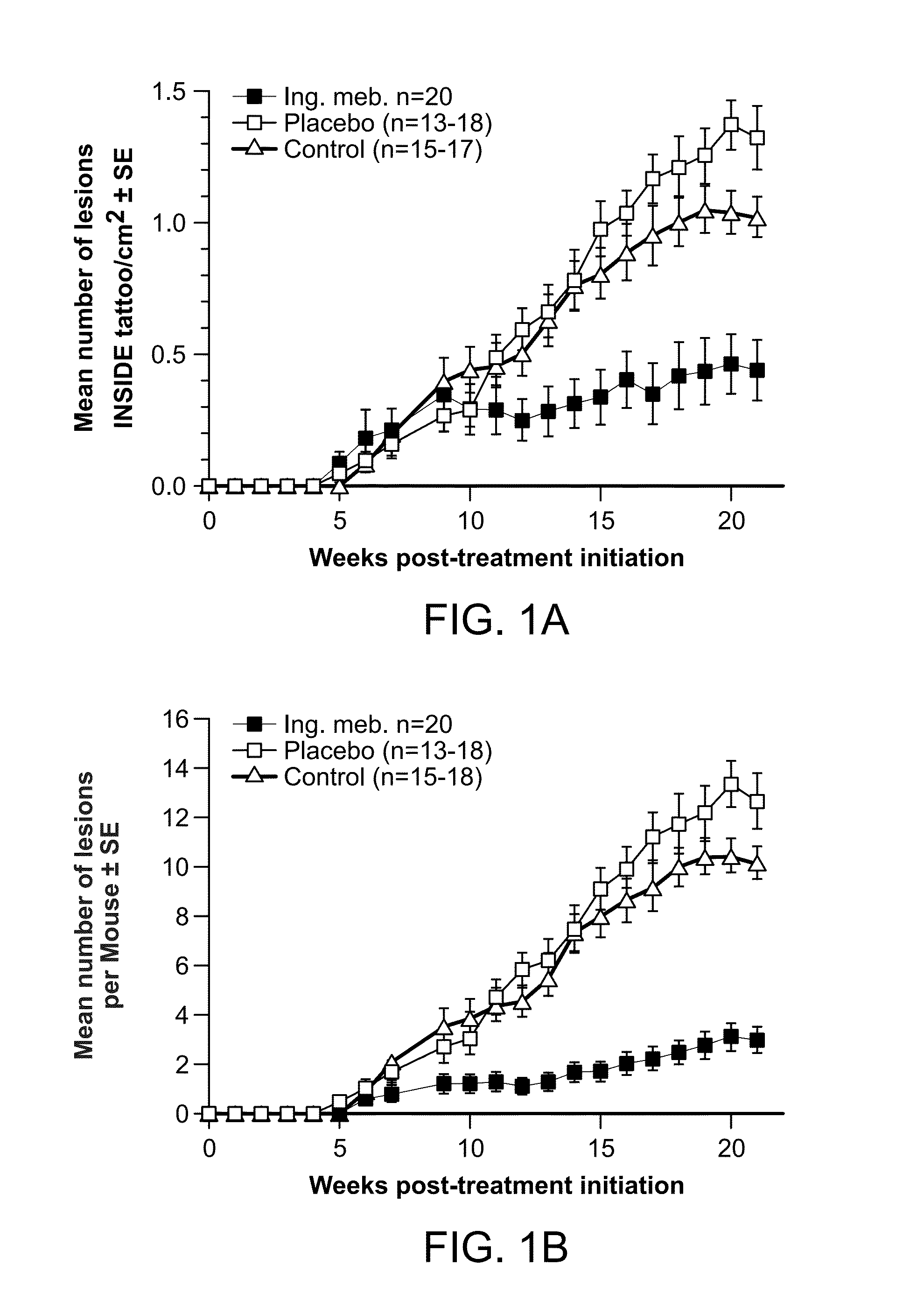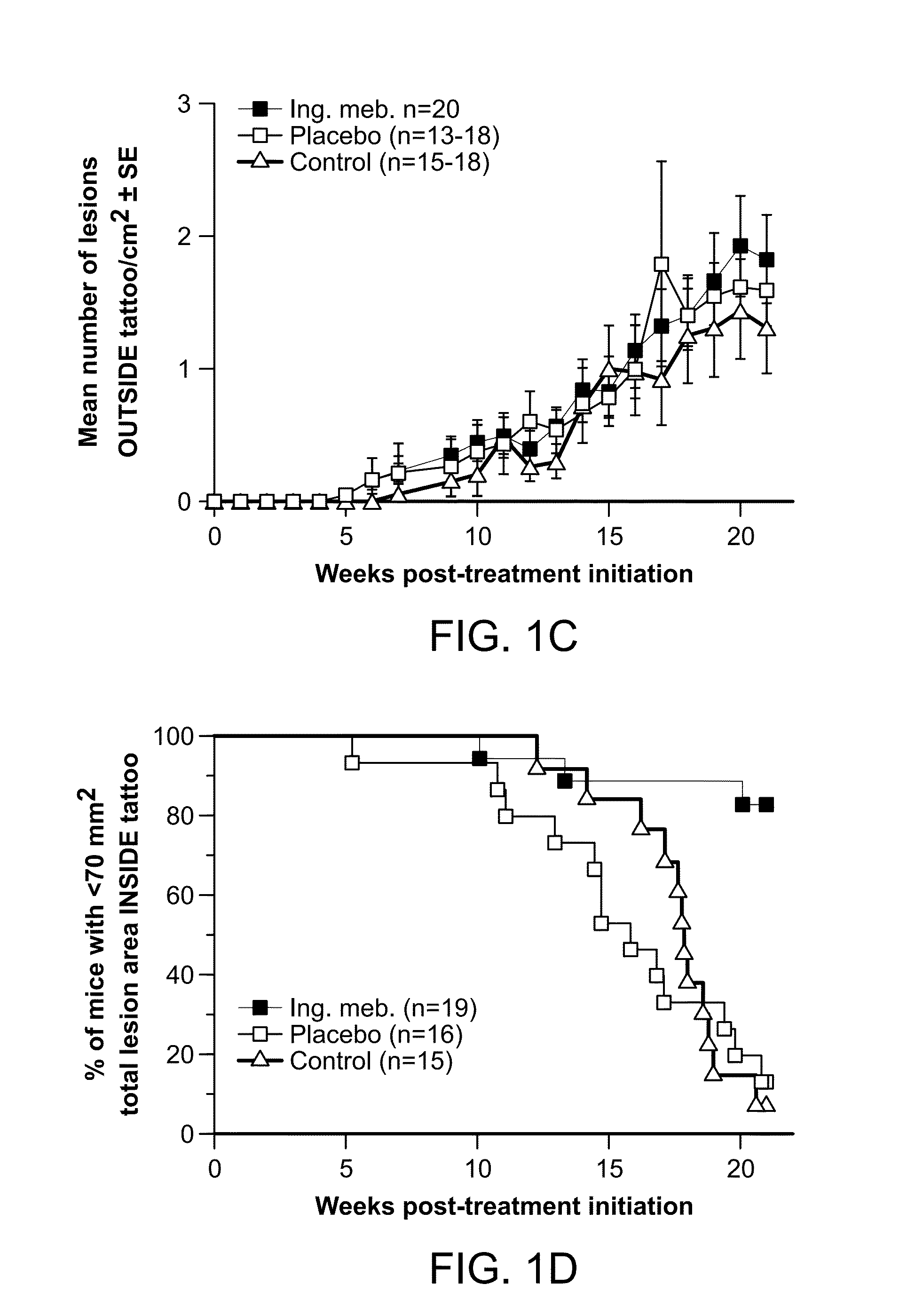Methods for treating uv-damaged skin and scc tumors and for removing tattoos with topical ingenol mebutate
a technology of ingenol mebutate and skin lesions, applied in the field of photodamaged skin with topical ingenol mebutate, can solve the problems of numerous health problems, suppression of the immune system, sunburn depending on the skin type of an individual, etc., and achieve the effect of reducing the number of skin lesions and reducing or cure the nymber of scc tumors
- Summary
- Abstract
- Description
- Claims
- Application Information
AI Technical Summary
Benefits of technology
Problems solved by technology
Method used
Image
Examples
example 1
The SKH1 / Hr Model
[0145]Outbred SKH1 / hr mice were obtained from Charles River Laboratories (Wilmington, N.C., USA) and a breeding colony for outbred SKH1 / hr mice was established at QIMR. Male SKH1 mice were used for this study. To prevent any fighting and injury (which promotes tumors), mice were kept two per cage, with mice separated by a physical barrier. All animal experiments were approved by the QIMR Animal Ethics Committee.
UVB Irradiation
[0146]Outbred SKH1 / hr mice were irradiated 3 times per week for 10-11 weeks under 6×TL-12 / 40 W fluorescent tubes (Phillips, Amsterdam, The Netherlands) mounted in parallel. The lamps emit 54% UVB (280-315 nm) and 46% UVA (315-400 nm) (Rebel et al., 2001). During the irradiation mice were segregated into individual boxes (11.5×20 cm) with a piece of 0.125 mm cellulose acetate placed over the box to prevent any UVC reaching the mice. The mice were 26 cm below the UV lamps. Under these conditions the mice received 1.25 times the minimal erythemal ...
example 2
1. Summary
[0169]The aims of this research were to determine the prophylactic activity of PEP005 in the field treatment of ultraviolet B radiation (UVB)-damaged skin, and the therapeutic activity of PEP005 in the treatment of UVB-induced skin lesions. The outbred SKH1 / hr mouse model of UVB-induced p53 mutant (p53+) patches and lesions (previously established at QIMR) was used to address these aims. Topical field treatment with 0.05% PEP005 of SKH1 mice with Photo-damaged skin resulted in significantly fewer p53+ patches / cm2, reduction of the UV induced epidermal thickening, and a reduction in cutaneous mast cells. Field treatment of a ˜10 cm2 dorsal area of skin, which contained most of the UV damaged skin, with 0.05% PEP005 gel resulted in a ˜70% reduction in the number of UVB-induced skin lesions that emerged after UVB irradiation. These studies support the utility of PEP005 gel for prophylactic field treatment of UVB damaged skin. Topical spot therapy of established UVB-induced le...
example 3
[0272]Outbred SKH1 / hr mice were irradiated 3 times per week (Monday, Wednesday, and Friday) for 10-11 weeks under 6×TL-12 / 40 W fluorescent tubes (Phillips) mounted in parallel. During the irradiation mice were segregated into individual boxes (11.5×20 cm) with a piece of 0.125 mm cellulose acetate placed over the box to prevent any UVC reaching the mice. The mice were 26 cm below the UV lamps. Under these conditions the mice received 1.25 times the minimal erythemal dose (MED) of UVB at each exposure, with the total UVB dose being 37.5 MED. One MED was defined as the minimal UVB dose, which caused erythema-oedema evident by visual examination. This MED dose had been previously established as suitable for these studies. UVB-irradiation was ceased for 2-7 days if any of the mice within a cohort showed signs of overt erythema, and was resumed once the overt erythema had resolved. Such cessation was usually only necessary after the initial 2-3 doses of UVB, as mice become resistant to U...
PUM
| Property | Measurement | Unit |
|---|---|---|
| Fraction | aaaaa | aaaaa |
| Fraction | aaaaa | aaaaa |
| Percent by mass | aaaaa | aaaaa |
Abstract
Description
Claims
Application Information
 Login to View More
Login to View More - R&D
- Intellectual Property
- Life Sciences
- Materials
- Tech Scout
- Unparalleled Data Quality
- Higher Quality Content
- 60% Fewer Hallucinations
Browse by: Latest US Patents, China's latest patents, Technical Efficacy Thesaurus, Application Domain, Technology Topic, Popular Technical Reports.
© 2025 PatSnap. All rights reserved.Legal|Privacy policy|Modern Slavery Act Transparency Statement|Sitemap|About US| Contact US: help@patsnap.com



